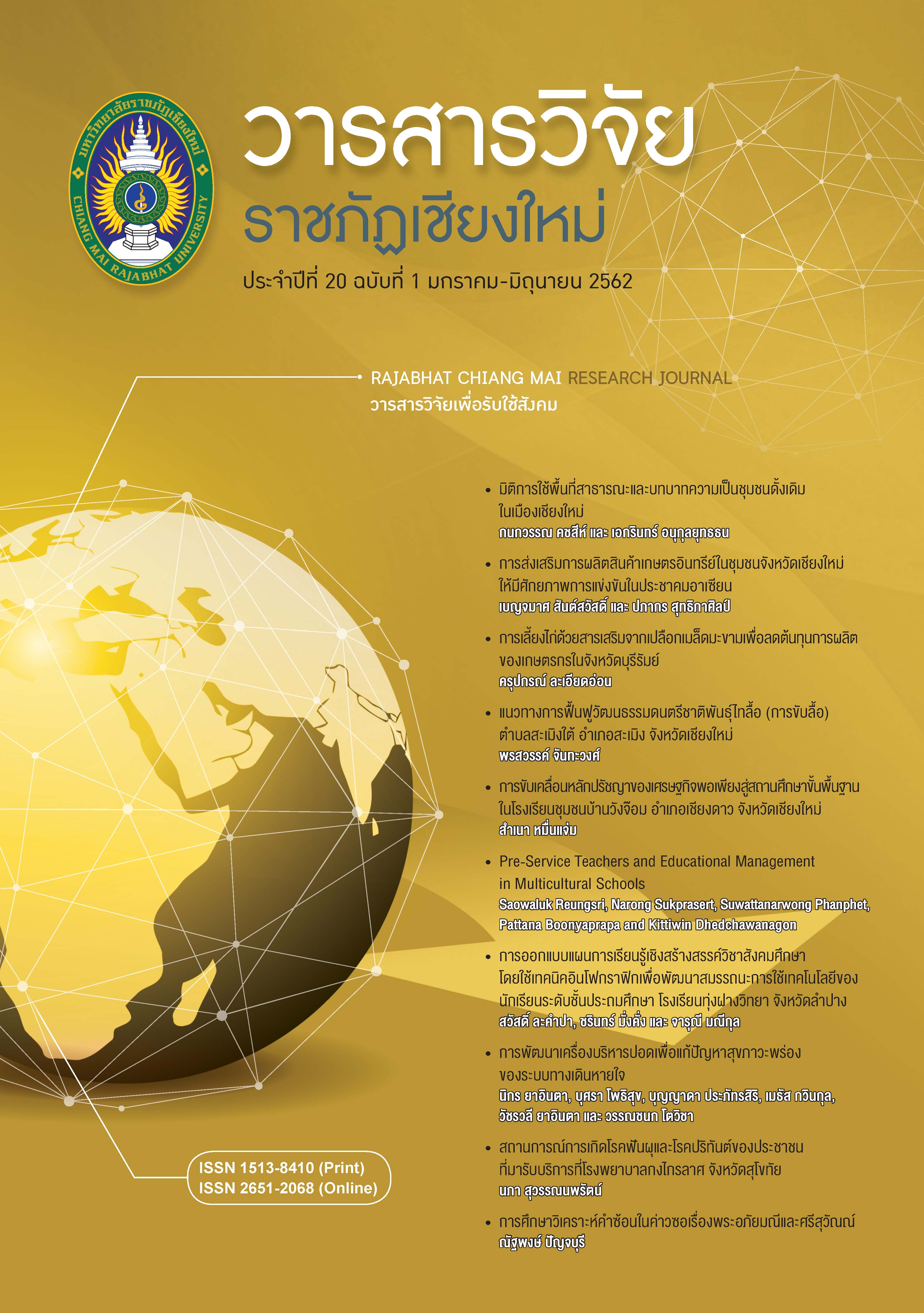Development of spirometer to solve the problem of respiratory system
DOI:
https://doi.org/10.14456/rcmrj.2019.185127Keywords:
Spirometer, Respiratory, Health, Spirometer, Respiratory, HealthAbstract
This research aims to study the problems of health in the respiratory system, the make the Spirometer and to study the effect of using the Spirometer to problem solving of health in the respiratory system that is an experimental research. The populations used in the research have 2 groups, including elderly volunteers (aged over 60 years old) and volunteers under 60 years old in the area of Tha Klwang Municipality, Saraphi District, Chiang Mai Province. The populations used in collecting data are 50 samples.
It was found that the elderly often find the problem of respiratory system, including the capacity of the lungs will decrease which is leading to Atelectasis to the elderly easily and it still found the diseases of respiratory system, namely Asthma, Tuberculosis, Chronic Obstructive Pulmonary Disease and Emphysema. Therefore, a way to be able to help the lungs expansion that is to exercise the lungs by means of wind suction that will make the body to get more oxygen and help to breathe more efficiently The production of an Incentive Spirometer NK1 is to develop for using as a tool to help the lungs expansion that is designed according to scientific principles and the effectiveness of the Incentive Spirometer by using the principle of replacing the wind with water in order to measure the volume of air that will go into the lungs. The result of using Spirometer in the Incentive Spirometer NK1 found that does not negatively affect to health of the tester in any way, but there is good result for those who have high blood pressure by having the trend of decreasing after the test of 77.27 percent, in the elderly can help increase the air volume to the lungs at good level (940 cc.), and at a very good level (1233 cc.) with normal group.
Downloads
References
จริยา พรหมสุวรรณ. (2552). การทบทวนงานวิจัยอย่างเป็นระบบเกี่ยวกับประสิทธิผลการฟื้นฟูสมรรถภาพปอดต่อการลดอาการหายใจลำบากในผู้ป่วยโรคปอดอุดกั้นเรื้อรัง. รายงานวิจัย. วิทยาลัยพยาบาลบรมราชชนนีสงขลา.
จันทรา เพ็ชรมาก. (2551). เปรียบเทียบผลของการออกกำลังกายกล้ามเนื้อหายใจโดยใช้เครื่องกระตุ้นหายใจกับยางยืดที่มีตอสมรรถภาพปอด. วิทยานิพนธ์วิทยาศาสตรมหาบัณฑิต. บัณฑิตวิทยาลัย มหาวิทยาลัย เกษตรศาสตร์.
จินตนา ประชุมพันธ์. (2561). PM2.5 ฝุ่นละอองขนาดเล็กในอากาศ กับวิกฤตสุขภาพที่คนไทยจะต้องแลก. THE STANDARD. สืบค้นจาก https://thestandard.co/pm-2-5-environmental - nano-pollutants
ถาวร วาจนศิริ. (2556). การออกแบบและสร้างเครื่องวัดปริมาตรอากาศขณะหายใจแบบดิจิตอล. วิทยานิพนธ์วิทยาศาสตรมหาบัณฑิต. บัณฑิตวิทยาลัย มหาวิทยาลัยเทคโนโลยีพระจอมเกล้าพระนครเหนือ.
ประเสริฐ อัสสันตชัย. (2552). ผู้สูงอายุกับระบบการหายใจ. คณะแพทยศาสตร์ศิริราชพยาบาล มหาวิทยาลัยมหิดล.
เมธี จินะโกฏิ และการันต์ พงษ์พานิช. (2561). บทความฟื้นวิชา การเปลี่ยนแปลงของระบบหายใจในผู้สูงอายุและการจัดการทางกายภาพบำบัดทรวงอก. เวชสารแพทย์ทหารบก, 71(4), 279-283.
วนิดา จีนศาสตร์. (2551). มลพิษอากาศและการจัดการคุณภาพอากาศ. กรุงเทพฯ: จุฬาลงกรณ์มหาวิทยาลัย.
สมศักดิ์ โล่เลขา. (2560). แพทย์ผู้เชี่ยวชาญ...ชี้วิกฤตมลพิษ ส่งผลคนไทยป่วยโรคระบบทางเดินหายใจ. สืบค้นจาก www.ryt9.com/s/tpd/2530516
สำนักโรคจากการประกอบอาชีพและสิ่งแวดล้อม. (2555). โรคและภัยสุขภาพจากปัญหาหมอกควัน. กรมควบคุมโรค.
Downloads
Published
How to Cite
Issue
Section
License
1. Articles, information, content, images, etc published in the “Community and Social Development Journal” are copyrighted by the Community and Social Development Journal, Chiang Mai Rajabhat University. In order to properly distribute the articles through print and electronic media, the authors still hold the copyright for the published articles under the Creative Commons Attribution (CC BY) license, which allows the re-distribution of the articles in other sources. References must be made to the articles in the journal. The authors are responsible for requesting permission to reproduce copyrighted content from other sources.
2. The content of the articles appearing in the journal is the direct responsibility of the article authors. The editorial board of the journal does not necessarily agree with or share any responsibility.














